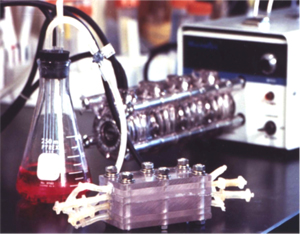News & Events
Prof. Wu awarded pilot grant for tissue engineering model
 Decoding how the genes of our immune system respond to infection is critical to developing vaccines against a host of emerging disease threats –MERS, SARS, and new strains of influenza.
Decoding how the genes of our immune system respond to infection is critical to developing vaccines against a host of emerging disease threats –MERS, SARS, and new strains of influenza.
The laboratory of David Wu, Professor of Chemical Engineering, is working on a tissue engineering model that would help scientists to do just that, on a scale that could never be achieved with petri dishes and mouse subjects.
At the heart of this model is a bioreactor that uses polymer scaffolding to sustain donated human spleen, tonsil and other lymph node tissues that are part of the body's main defense against infection. This would allow researchers to study in far greater detail how the human immune system responds to infection at the genome level.
The opportunity to grow tissue in a 3D environment is critical, Wu noted. The immune tissues being studied form a complex 3D architecture in the body that is necessary for cell survival as well as function. For example, B-lymphocytes, which play a key role in our immune response, typically die out quickly in petri dish or flask cultures. "So there is no way you can start an immune response" in that kind of environment, said Wu. "However, B-lymphocytes survive quite well in our 3D culture."
The ability to work with human tissues – rather than mice -- will make the findings all the more relevant to actual vaccine development, Wu noted.
Project gets pilot grant from CIBEM
Wu was recently awarded a pilot grant from the University's Center for Integrative Bioinformatics and Experimental Mathematics (CIBEM). The Center was created in 2012 within the Department of Biostatistics and Computation Biology to integrate and consolidate the University's bioinformatics and computational biology resources.
The award will help Wu's lab continue to refine the 3D immune culture system, optimizing the polymer matrix, growth conditions, and extracellular factors to most closely approximate the in vivo conditions in which immune organs function. And the award will hopefully pave the way for an even larger grant from external sources.
The project is particularly timely given recent advances in DNA sequencing technology. It is now possible to sequence the human genome – the complete set of an individual's genetic information – at a fraction of the cost and time that would have been incurred just a few years ago.
'We can expect to learn a lot from this collaboration'
By also analyzing changes in gene expression and protein biosynthesis at the genome level, as facilitated by high-throughout DNA-sequencing and proteomics technologies, Wu and his collaborators hope to discern the entire profile of molecular events that occur in our immune system in response to infection.
Wu is excited to be contributing to a new frontier of research, representing a "marriage between information technology and life science engineering."
By combining tissue engineering with "next-generation DNA sequencing," Wu notes, "we can study immune response by sequencing all the genes that get expressed or repressed when a human being is exposed to infection. We expect to learn a lot from this collaboration."
